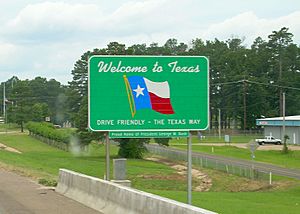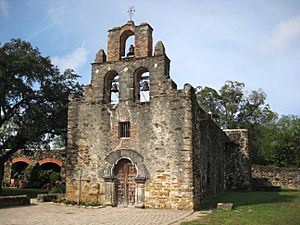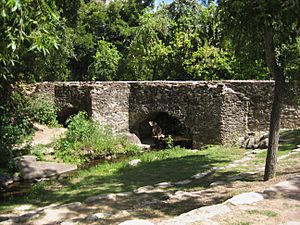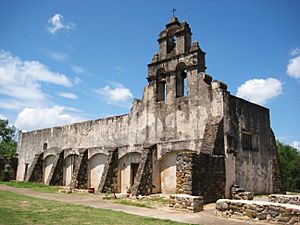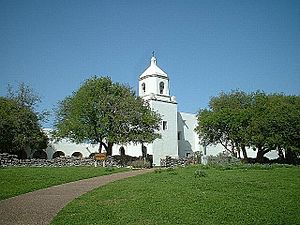Spanish missions in Texas facts for kids
The Spanish Missions in Texas were special places built by Spain a long time ago. These missions were like outposts set up by Catholic priests from groups like the Franciscans. Their main goal was to teach Native Americans about the Catholic faith. But they also helped Spain claim and control new lands.
These missions brought many new things to the Texas area. They introduced European livestock like cows and horses. They also brought new fruits, vegetables, and different kinds of work. Along with forts (called presidios) and towns (called pueblos), missions were a key way Spain expanded its empire. In total, twenty-six missions were built in what would become the state of Texas.
Spain had been building missions in New Spain (which included Mexico and parts of the southwestern United States today) since 1493. The missions in eastern Texas were built because Spain was worried about French people moving into the area. This fear grew when the remains of La Salle's Fort Saint Louis were found near Matagorda Bay in 1689.
The Franciscan missionaries wanted Native Americans living at the missions to learn Spanish ways of life. They hoped these communities would become like Spanish villages. Native Americans learned many useful skills. They learned how to use plows and farm tools. They also learned how to care for horses, oxen, and mules. Skills like blacksmithing and Weaving were very important. As buildings became more complex, people learned masonry (working with stone) and carpentry.
The goal was for Native Americans to become Christians and learn Spanish customs. Eventually, they would no longer need the special mission status. This process was called "secularization." It meant the mission's shared lands became private property. The church's control shifted from the missionaries to the regular Catholic church. While there was no set time for this to happen, many missions were secularized in the late 1700s.
The mission system was created to prevent problems. Sometimes, Spanish settlers and soldiers treated Native Americans badly, even enslaving them. This caused a lot of conflict. The missions were supposed to offer a more controlled and protective environment.
However, the mission system could not fully protect Native Americans. Ranchers and other businesses wanted control over mission lands. They also wanted the Native Americans to work for them. Between 1824 and 1830, after Mexico became independent, almost all missions in Texas were officially secularized. Only those near El Paso remained missions until 1852.
Contents
- Missions in Spanish Texas
- Mission San Francisco de la Espada
- Mission Santísimo Nombre de María
- Mission San Juan Capistrano
- Mission Nuestra Señora de la Purísima Concepción de Acuña
- Mission Nuestra Señora de Guadalupe de los Nacogdoches
- Mission Nuestra Señora de los Dolores de los Ais
- Mission San Miguel de Linares de los Adaes
- Mission San Antonio de Valero
- Mission San José y San Miguel de Aguayo
- Mission Nuestra Señora del Espíritu Santo de Zúñiga
- Mission Santa Cruz de San Sabá
- Mission Nuestra Señora del Rosario
- Mission Nuestra Señora del Refugio
- Missions Outside Spanish Texas Borders
- See also
Missions in Spanish Texas
Spanish Texas was a part of New Spain. Its southern border was the Medina and Nueces Rivers, about 100 miles (160 km) northeast of the Rio Grande. To the east, Texas bordered French Louisiana. Spain claimed the Red River as the border. However, France said the border was the Sabine River, 45 miles (72 km) to the west.
Mission San Francisco de la Espada
This was the first mission built in what became Spanish Texas. In 1689, Spanish explorers found what was left of a French settlement called Fort Saint Louis.
The Spanish met the Caddo people, who lived between the Trinity and Red Rivers. The Caddo seemed interested in Christianity. So, in 1690, Alonso De León led a group to build a mission in East Texas. It was finished near the Hasinai village of Nabedaches in May. The first mass was held on June 1, 1690.
The mission faced many problems early on. Floods and then a drought ruined their crops. An illness killed half of the local people. The Hasinai believed the missionaries caused the deaths. Fearing an attack, the missionaries buried the mission bell, burned the building, and left for Mexico in 1693.
The mission was rebuilt in 1716 as Nuestro Padre San Francisco de los Tejas. In 1721, it was renamed Mission San Francisco de los Neches. It moved to San Antonio in 1731 and became Mission San Francisco de la Espada. The old buildings are now part of San Antonio Missions National Historical Park. A replica of the original mission is at Mission Tejas State Park in Weches.
Mission Santísimo Nombre de María
This was the second mission built by the Spanish in East Texas. It was for the native Neches people. The mission opened in September 1690, about 6 miles (9.7 km) northeast of Mission San Francisco. It had a straw chapel and a house for the priest. A flood destroyed it in 1692.
Mission San Juan Capistrano
This mission was first called Mission San José de los Nazonis in East Texas. When it moved to San Antonio in 1731, it was renamed. This was to avoid confusion with Mission San José y San Miguel de Aguayo. It was about 3 miles (4.8 km) south of Mission San José. It served the Coahuiltecan Native Americans. It was the furthest mission from the fort at Bexar and often faced raids from Apaches.
By 1762, the mission had a stone chapel and stone rooms for priests and soldiers. Adobe rooms were built along the walls for about 200 Native Americans. The mission was secularized in 1794. Its land was divided among the remaining Native Americans. A priest continued to hold church services, but other mission activities stopped. The church has been restored and is still used today.
Mission Nuestra Señora de la Purísima Concepción de Acuña
This mission first opened in 1716 on the Angelina River in East Texas. It was called Mission Nuestra Señora de la Purísima Concepción de los Ainais and served the Ainais tribe. It closed due to a French threat but reopened in 1721. In 1730, it moved temporarily to Austin before settling in San Antonio in 1731. There, it was renamed Mission Nuestra Señora de la Purísima Concepción de Acuña. The name changed because it no longer served the Ainais tribe. The new name honored the viceroy of Mexico.
The mission took over the lands of the closed Mission San Franscisco Xavier de Najera. This was about 3 miles (4.8 km) south of San Antonio de Valero. Most Native Americans here were Coahuiltecans. They often disliked the hard work at the mission and would run away. Soldiers or priests would then bring them back.
The church building you see today was finished in 1755. It is the oldest stone church in the United States that has not been heavily restored. It is shaped like a cross, with very thick walls (45 inches or 1.1 m). The mission closed in 1794. Its property was divided among the Native Americans living there, but all had left by 1800. For a while, the buildings were used for cattle. In 1855, the land and church were given to the Brothers of Mary. They cleaned it up and started services again. It is now open to the public and is part of the National Park Service.
Mission Nuestra Señora de Guadalupe de los Nacogdoches
This mission was started in 1716. It was located in East Texas and served the Nacogdoche tribe. It closed for a few years because of threats from French Louisiana. But it reopened in 1721. The mission continued until 1773. At that time, the Spanish government ordered everyone to leave East Texas. In 1779, Antonio Gil Y'Barbo led a group of settlers back to the empty mission buildings. This was the beginning of the town of Nacogdoches, Texas.
Mission Nuestra Señora de los Dolores de los Ais
This mission was first built in 1717 near Ayish Bayou (modern San Augustine, Texas). Father Antonio Margil de Jesus established it to convert the local Ais Native Americans. After a conflict called the Chicken War in 1719, Spanish officials closed the East Texas missions. Father Margil moved to San Antonio. The next year, he founded Mission San José (Texas). Mission Dolores was reopened in 1721. Missionaries worked there until 1773, when the East Texas missions closed again.
Archaeologists found the mission's exact location in the late 1970s. It is one of only three confirmed mission sites in East Texas. It is also the only one open to the public. The City of San Augustine built a museum and lab there in 2000. Since 2016, the Texas Historical Commission has managed the site as Mission Dolores State Historic Site.
Mission San Miguel de Linares de los Adaes
This was the fifth mission built in East Texas, around 1716–1717. It was meant to serve the Adaes Native American village. This village was only 20 miles (32 km) west of a French fort in Natchitoches, Louisiana. Spain claimed the Red River as Texas's eastern border. So, the mission was considered part of Spanish Texas, even though it's now in Louisiana.
French soldiers attacked the mission in 1719, and it closed. Three years later, the Marquis de San Miguel de Aguayo reopened it. He chose a spot closer to the Presidio of Los Adaes (fort). The mission stayed open until 1773.
Mission San Antonio de Valero
Mission San Antonio de Valero was founded on May 1, 1718. It was the first Spanish mission along the San Antonio River. It was named after San Antonio de Padua and the viceroy of New Spain. This mission later became famous as the Alamo.
It was first located west of San Pedro Springs. After moving a few times, it settled near a bend in the San Antonio River, which was easy to defend. Early mission buildings were made of grass. The first stone building was built in 1727. The building known today as the Alamo was built in 1744. Most of its original structure is gone. The mission eventually had a granary, workhouse, and rooms for priests, Native Americans, and soldiers. A wall protected the buildings from frequent Apache raids. Outside the wall were farmlands and ranches owned by the mission.
The mission served the Coahuiltecan Native Americans until 1793. At that time, mission activities ended. The land and animals were divided among the thirty-nine Native Americans still there. The buildings later housed a Mexican army unit. In 1806, it became a military hospital. During the Texas Revolution, it was the site of the Battle of the Alamo. During the Mexican–American War, supplies for the U.S. Army were stored there. Today, the state of Texas owns the buildings. The Daughters of the Republic of Texas operate it as a memorial.
Mission San José y San Miguel de Aguayo
Soon after Mission San Antonio de Valero was founded, it became too crowded. Many Native Americans from closed East Texas missions moved there. Father Antonio Margil got permission to build a new mission. On February 23, 1720, Mission San José y San Miguel de Aguayo was established. It was about 5 miles (8.0 km) south of San Antonio de Valero. Like San Antonio de Valero, Mission San José served the Coahuiltecan Native Americans. The first buildings were made of brush, straw, and mud. These were quickly replaced by large stone structures. These included guest rooms, offices, a dining room, and a pantry. A strong outer wall was built around the main part of the mission. Rooms for 350 Native Americans were built into the walls.
A new church, which still stands, was built in 1768 from local limestone. The mission lands were given to its Native Americans in 1794. Mission activities officially ended in 1824. After that, the buildings were home to soldiers, homeless people, and bandits. It was restored in the 1930s. It is now a state and national historic site.
Mission Nuestra Señora del Espíritu Santo de Zúñiga
- This mission was started in 1722 near Matagorda Bay. That's why it was called "La Bahia" (The Bay). It was for the Karankawa Native Americans.
- It moved in 1726 near Victoria.
- It moved again in 1749 to La Bahia (now Goliad, Texas).
- This mission became the first large cattle ranch in Texas. By 1778, it had almost 40,000 free-roaming cattle. Native American cowboys, called vaqueros, cared for the cattle and wild horses.
- They also grew large amounts of grain, fruit, and vegetables. This fed the residents and allowed them to trade with others. Cattle and livestock were also traded with other missions in Texas and Louisiana.
- The mission was officially secularized in February 1830.
- It was restored from ruins in the 1930s by groups like the Civilian Conservation Corps.
- Today, it is a state historical park run by the Texas Parks and Wildlife Department.
Mission Santa Cruz de San Sabá
- This mission was started in 1757 by Franciscan missionaries.
- They lived among the Lipan Apache people.
- This was the first place where the Spanish and the Comanche had a conflict.
- About 2,000 Comanche warriors and their allies destroyed the mission in March 1758.
- Even though the mission was gone, the nearby Presidio San Luis de las Amarillas (fort) continued until 1772.
Mission Nuestra Señora del Rosario
- This mission was established in 1754. It was 4 miles (6.4 km) west of La Bahia. It served various Karankawan tribes.
- The mission developed a huge ranching system.
- In 1781, its livestock were moved to Mission Nuestra Señora del Espíritu Santo de Zúñiga.
- Rosario officially joined with Mission Nuestra Señora del Refugio on February 7, 1807.
- Rosario was not secularized until 1828, with the order carried out in 1831.
- Today, the ruins are an archaeological site. It is called Mission Rosario State Historic Site and is part of Goliad State Park and Historic Site.
Mission Nuestra Señora del Refugio
- This mission was established on February 4, 1793, in East Texas.
- It moved in June 1794 to Mosquitos Creek.
- It moved again in January 1795 to Refugio.
- On January 7, 1830, the official secularization order was carried out, and Refugio was abandoned.
- Materials from the ruins were likely used to build new structures in the early 1800s. The site is now owned by Our Lady of Refuge Catholic Church.
Missions Outside Spanish Texas Borders
Mission Corpus Christi de la Ysleta
- Founded in 1682.
- The Tiwa tribe gathered at this site.
- It was located in El Paso.
- Flooding destroyed the mission twice: around 1742 and again around 1829.
- The current church was built in 1851 on higher ground.
- In 1881, the Jesuits took control and renamed it Mission de Nuestra Señora del Monte Carmelo.
- In 1980, the name changed to Mission San Antonio de los Tiguas.
- It is still used as a church today.
Mission San Antonio de Senecú
- Established in 1682, about 1¼ miles (2.0 km) from Ysleta.
- It was settled by Piro people from New Mexico.
- The river moved, and now the site is in Ciudad Juárez, Mexico.
Mission Nuestra Señora de la Limpia Concepción de Los Piros de Socorro del Sur
- Established in 1682.
- The Piros people gathered at this site.
- It was located near Socorro.
- The first permanent mission, built in 1691, was washed away by a flood in 1744.
- A second church was also washed away in 1829.
- The current mission was completed in 1843.
- Socorro became part of Texas in 1848.
Mission San Juan Bautista
- Established between 1700 and 1702.
- The site is now in Guerrero, Coahuila, Mexico.
- Coahuiltecan Native Americans (Ocán, Pacuache, and Pacal) gathered here.
- This was the third mission of the San Juan Bautista group.
- It was also the site of a Presidio (fort).
See also
 In Spanish: Misiones españolas en Texas para niños
In Spanish: Misiones españolas en Texas para niños


